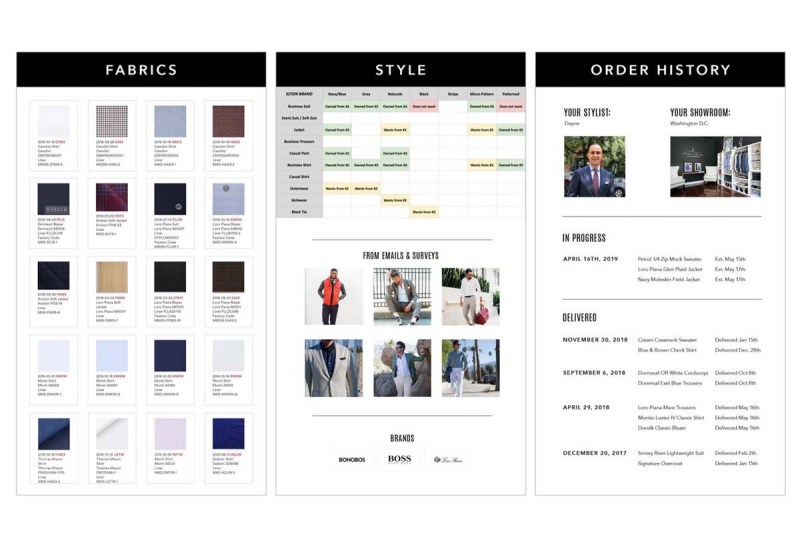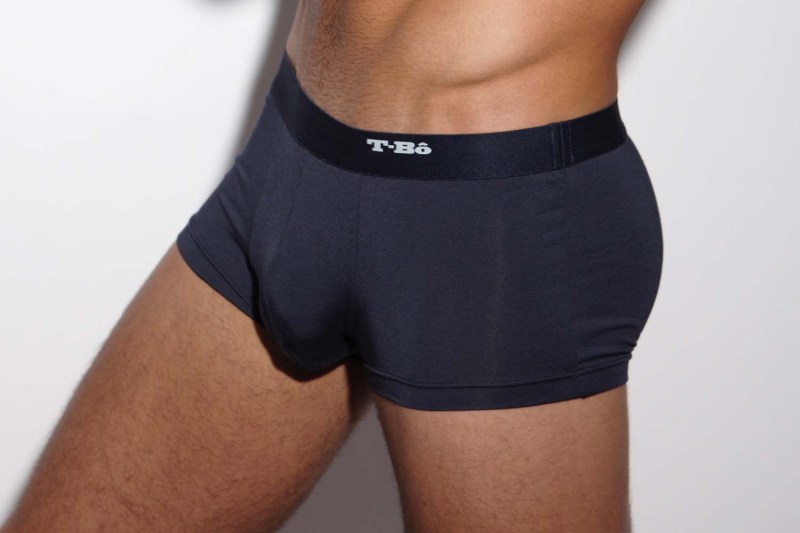The Philip K. Dick sci-fi thriller Minority Report has become a touchstone for advertisers and retailers alike; referencing the scene where Tom Cruise’s character John Anderton is called by name as he moves through one scene … and by another after he’s had some sketchy eye replacement surgery. While most watchers decry the scene as creepy, the marriage of cutting-edge technology and retail is definitely changing the shopping experience — usually for the better. While scandalous stories about sharing personal data have certainly been hitting the headlines lately, there’s still plenty of ways that tech can add fun to the shopping experience. We talked to four different brands who are using tech to make your shopping experience more enjoyable, more personalized, and even more effective.
Knot Standard

Walk into any location of custom clothier Knot Standard and you’ll be greeted with an appropriately custom shopping experience. High-def televisions scattered throughout the space will show a mixture of still and moving images: all keyed toward your shopping needs for the day. Looking for a great sport coat? Displays will feature the brand’s suggested offerings for the season, from models wearing the clothes to still lifes; complete with pairing suggestions and fabric swatch close-ups. Already a customer? They’ll even include items from your existing Knot Standard wardrobe that will work with the new recommendations.
Cofounder Matt Mueller describes it as “like walking into your own art gallery. As our stylists get feedback from the client, they are able to hone in on what he likes or dislikes, so by the time they sit down for the actual consultation, it’s almost an afterthought.”
The system is easy for the consultant to use. Mueller even toyed with using Siri commands for the presentation at one point, but it seemed to break up the conversation between stylist and client. Once stylist and client are ready to sit and make final decisions, the presentation moves with them into a private setting where culled-down images are shown to complement swatches, button choices, etc.
“We can even include custom pictures of clients,” adds Mueller, “something we’ve done when clients take over our space for special events (like fittings for a wedding party). We’ll have several displays set up with tuxedos, then use the displays to show other ways to wear and style the looks.”
The fun isn’t over upon leaving. “We provide an instruction manual for our clothes: how to wear it, how to pair it with existing items in your wardrobe. All the information is available on a microsite that’s created from the images we use in the shop. Just take a picture of the QR code that we include inside our garments for suggested options … of course we will also make some suggestions for some new things to go with that piece, so you’ll want to come back into the studio later.”
Method of Denim

Bring that bespoke experience to your denim wardrobe with Australian company Method of Denim. At the brand’s website, customers start by choosing from a general style selection of skinny, straight, or slim silhouettes in washed, vintage, indigo, or black. In the next step, shoppers answer some key questions like height, weight, and standard size; and follow with a handful of measurements of their calves, thighs, butt, etc. No worries there, mate: the site provides easy-to-follow images and videos for each step. MOD’s algorithm then predicts the best fit for your body. (We walked through the process, and it was pretty easy. We would suggest making life easy by using a metric system measuring tape. It also wouldn’t hurt to have another set of eyes available to help with reading the measurements.) Now that we’re done with the scientific part, it’s on to select from cropped, rolled, cut, or regular hems. You can even add distressed details, lettering, or select from Method’s graphics and patches.
The good news is that, by not maintaining any inventory and making each pair to order, there is a major contribution to sustainability. No jeans are being shipped around the globe to end up stacked up in the sale bin. The bad news is that the jeans do cost a bit more than some—over $200 a pair, plus shipping, etc.—and you will have to wait about a month for the jeans to be delivered. But in the end, you’ll have a “perfect” pair of jeans. The same processes are also available for denim jackets, hoodies, sweatshirts, and tees, so keep these in mind for Instagrammable bachelor party gifts. Of course, just like custom suits, these jeans are also perfect for hard-to-fit athletic guys or anyone with a weight problem (the brand can handle guys from just over 4 feet up to about 7 feet tall, waist sizes around 26 to 60 inches)
T-Bô

Generally speaking, what’s in a guy’s underwear drawer is between him and, well, whoever is seeing him in his underwear … not counting the other guys in the locker room, of course. You wouldn’t think the whole community would need — or want — to be involved, until now.
T-Bô takes the concept of crowdsourcing to another dimension by inviting men from all over the globe to participate in underwear design, or, as the brand puts it, becoming “co-creational insights agents.” The brand was founded in 2017 by Roy Bernheim and Allan Perrottet in Switzerland. The pair were committed to creating a collection that is sustainable, but doesn’t compromise on comfort, style, or function. The brand’s current network of co-creators includes (at last count) more than 126,000 members. Agents offer insight into everything from color to fit, which the company then uses to create prototypes for the network to test. After gathering feedback from testers, the design is tweaked and adjusted here and there so the final product can be offered to the general public.
Current results of the massive collaboration include underwear styles The Must Have, The Ballsy, and The Comfy AF, each offered as both a boxer brief and a brief. Of course, there is also The Must Have undershirt to round out your underwear drawer. We also love the brand’s color choices, including hues like Surf The Web blue, and Pirate Black Stripes.
The concept goes beyond merch, though, to include input on marketing content, events, and even destinations for the company’s charitable contributions.
Atolla

So how many MIT graduates does it take to solve your skincare problems? Well, apparently, only two, so long as the two are Meghan Maupin and Sid Salvi. The two each struggled with their own skin issues. “When I first moved to Boston I was having major problems with eczema,” says Salvi. “I went to the drug store and bought every single moisturizer and tried every one.” Before he got to MIT, though, he’d been working in retail and data science. “Meghan’s background is design, so we ended up approaching this not as a skincare problem, but as a data science issue.”
Salvi points out that there’s no good way for a customer to really understand their skin. Oily? Dry? Compared to what?
”Only once you understand your skin can you connect with the right products,” says Salvi. “There’s a lot of bad information out there, and a lot of claims being thrown around. Our goal was to set up skincare so it’s measurable, and we can learn from the products that people use.”
Eventually the two joined forces with dermatology guru Dr. Ranella Hirsch to create Atolla. The system uses the duo’s machine learning algorithms and precision skin data to create personalized and adaptable serums. A subscription-based model, Atolla sends each customer a kit with test strips to analyze their own skin at home (or wherever) at their own leisure. (Remember those paper strips from high school chemistry class? They’re like that … only better.) You can then scan the strips with the brand’s app to get custom formulations.
Of course, as a good junior data scientist, you’ll continue to test your skin as it improves; sending updated data via the app for continually refocused treatments. As your skin changes — due to the season, changes in environment, hormonal or stress developments — the system will adjust with you for the best treatment.
While you’re waiting for Amazon to sort out that drone delivery service, enjoy some good old-fashioned retail technology … but skip the creepy sci-fi backroom implants.


